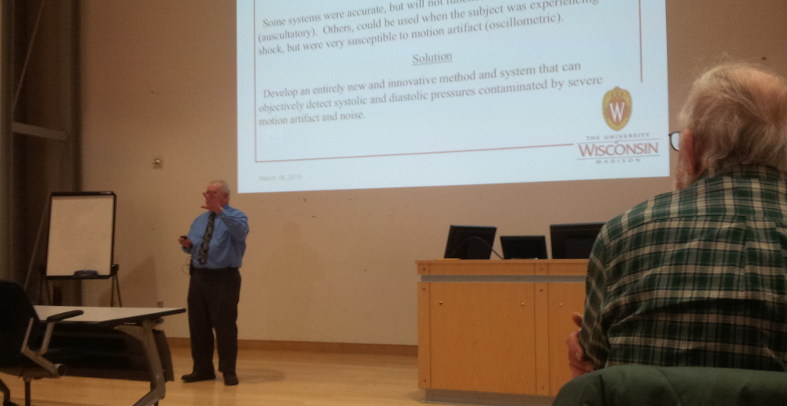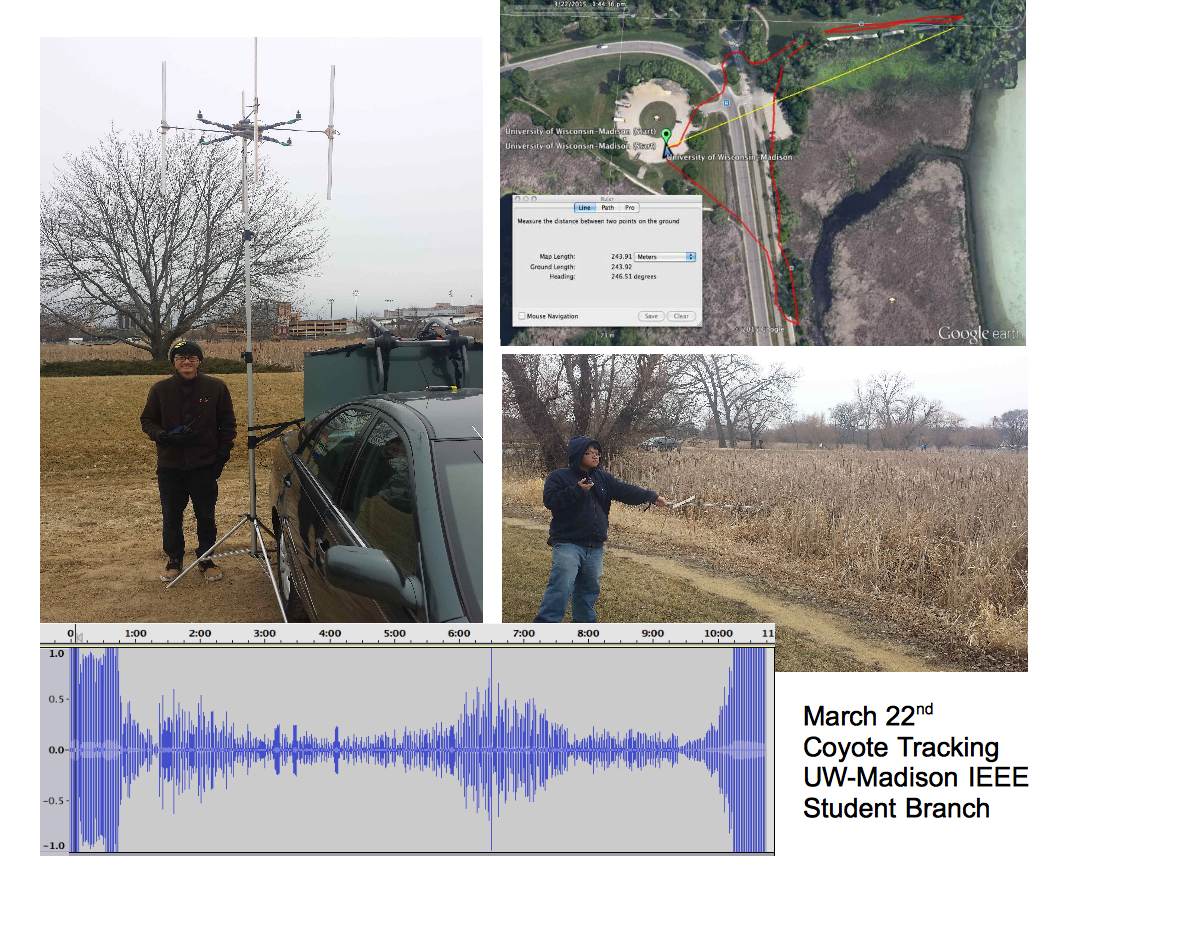

|
Madison Section NewsletterNewsletters are archived online at http://ieee-msn.truenym.net/news.html. |
| Vol. 18, No. 4 | Serving IEEE Members of South Central Wisconsin | April 2015 |


The
Life Member Affinity Group (LMAG): At the initial
organizing meeting, Charles Kime was elected as Chair and
Charles Cowie was elected as Vice Chair. Potential projects
for the group were Madison Science Museum (see
here), tutoring especially in Math for Middle School aged
children, and mentoring informally or through the official IEEE
Mentoring program. Also, the undergraduate IEEE-UW Student
Branch could use help mentoring students on projects. Faculty do
not have the time to engage students on a one-on-one basis.
Another possible project is for the LMAG to schedule Membership
Grade Promotion sessions for the IEEE-Madison Section for
promotion to Senior Member, in particular for members of
Industry. Programs: it
was thought that the LMAG could sponsor programs that were of
interest to the membership, but out of the normal technical
interest of the Section. Two possible programs discussed were History of Science
presentations and Educational
Outreach opportunities such as the UW-Madison “Senior
Guest Auditor” program to attend lectures of interest.
Interested in participating in the LMAG group? Please contact
Tom Kaminski (tjkaminski-at-ieee.org).
Engineers in Medicine and
Biology Talk: Dr.
Dennis Bahr, a Madison section member who has successfully
started a
number of biotech companies, talked to a joint meeting of
the
IEEE-Madison Engineers in Medicine and Biology Chapter and
the
UW-Madison Biomedical Engineering Department Seminar about
his latest biotech
venture involving a technology to diagnose hemorrhage
leading to
hemorrhagic shock. Shock is a life threatening condition
that is
difficult to diagnose using traditional vital signs
information
available to first responders, such as blood pressure,
heart rate,
respiration, and Sp02.This is especially true in young and
healthy
patients, whose vital signs don't change much until they
have lost
20% or more of their circulatory system blood volume. At
that point
it may be too late to save them.
Dennis's research suggests it may be possible to diagnose shock by measuring the time delay between the heart's electrical signals and the mechanical arrival of the pulse in the arteries of the arms. He is developing a device to measure the variations in this delay, giving first responders the ability to monitor and measure internal or external hemorrhage. He found empirically that when the blood pressure pulses pass under a blood pressure cuff the arteries in the arm snap open and can be heard as sound with a spectral peak at approximately 17Hz. When two microphones are used under the same cuff, motion artifact and noise can be removed from the blood pressure signal by looking at the phase relationships. In phase signals are noise and motion while out of phase signals are the blood pressure pulse.This device will become part of the hemorrhage monitoring system.
Dr. Bahr, his partner John Peterman, a small team of physicians, PhDs & technicians, and four students from the UW Department of Biomedical Engineering have built a Lower Body Negative Pressure (LBNP) chamber to simulate hemorrhage in healthy volunteers. If the results prove positive they will design and build a blood pressure cuff system that wraps around the arm and will contain a pump, battery, and visual display. It will measure blood pressure, heart rate, ECG, SpO2, and any blood loss or hemorrhage.

The March Section Meeting:(Review
by CJ Gervasi)
Ron Pulvermacher, founder and president of
Matrix Product Development in Sun Prairie, spoke to our Section
about the DASH-7 wireless standard. DASH-7 is a wireless
protocol structured as a “file” sharing system. “Files” in this
case are commands or data about devices. DASH-7 can perform
functions similar to Bluetooth Low Energy (BLE), but with
DASH-7, both sides of the link are designed for low power. In
BLE, only the slave side is designed to be low power. A DASH-7
master can ask all nodes that are observing a particular
condition to respond, allowing all other units to save power by
staying silent. Dash-7 operates in the sub 1 GHz band. The
433MHz frequency is popular in Europe where the power limits on
that band are higher. Using the 433 MHz band also buys users 15
dB less path cost compared to the 2.4GHz band used for BLE,
Zigbee and 802.11(g) Wi-Fi. DASH-7 modulation is 55kbps GFSK,
much slower than BLE’s 1 Mbps GFSK, which provides DASH-7 more
link budget but does not affect power budget. Matrix is
implementing a DASH-7 network on the CC430, a low-cost TI MCU
with a built in radio. In Summary, Dash-7 is a sub-gigahertz
Bursty, Lightweight, Asynchronous, Stealth, Transitional (BLAST)
wireless protocol.
UW-Madison IEEE Drone Project:
The UW-Madison Student Branch has formally started the
project to equip drones with RDF antennas and equipment for
tracking both wildlife, and people who wander, such as people
with Autism or Alzheimer's. Ten students have signed up for the
project and meet on a regular basis. They have formed a Google
Group and have set up a git site for logging software. Students
used prototype antennas to track coyotes in the Picnic Point
area.

 The Institute of Electrical and
Electronics Engineers or IEEE (read Eye-Triple-E) is an international
non-profit, professional organization dedicated to advancing
technology innovation and excellence for the betterment of humanity.
IEEE and its members inspire a global community through IEEE's highly
cited publications, conferences, technology standards, and
professional and educational activities. It has the most members of
any technical professional organization in the world, with more than
300,000 members in around 150 countries. The IEEE consists of 38
societies, organized around specialized technical fields, with more
than 300 local organizations that hold regular meetings. Discover what
IEEE Member Discounts can offer you. The Member Discounts portfolio
consists of insurance products and programs for the home, office and
travel, all at excellent group rates and reduced pricing. Visit IEEE
Member Discounts to see what’s available in your location and enjoy
the savings. For more information, please visit: IEEE.ORG.
The Institute of Electrical and
Electronics Engineers or IEEE (read Eye-Triple-E) is an international
non-profit, professional organization dedicated to advancing
technology innovation and excellence for the betterment of humanity.
IEEE and its members inspire a global community through IEEE's highly
cited publications, conferences, technology standards, and
professional and educational activities. It has the most members of
any technical professional organization in the world, with more than
300,000 members in around 150 countries. The IEEE consists of 38
societies, organized around specialized technical fields, with more
than 300 local organizations that hold regular meetings. Discover what
IEEE Member Discounts can offer you. The Member Discounts portfolio
consists of insurance products and programs for the home, office and
travel, all at excellent group rates and reduced pricing. Visit IEEE
Member Discounts to see what’s available in your location and enjoy
the savings. For more information, please visit: IEEE.ORG.

